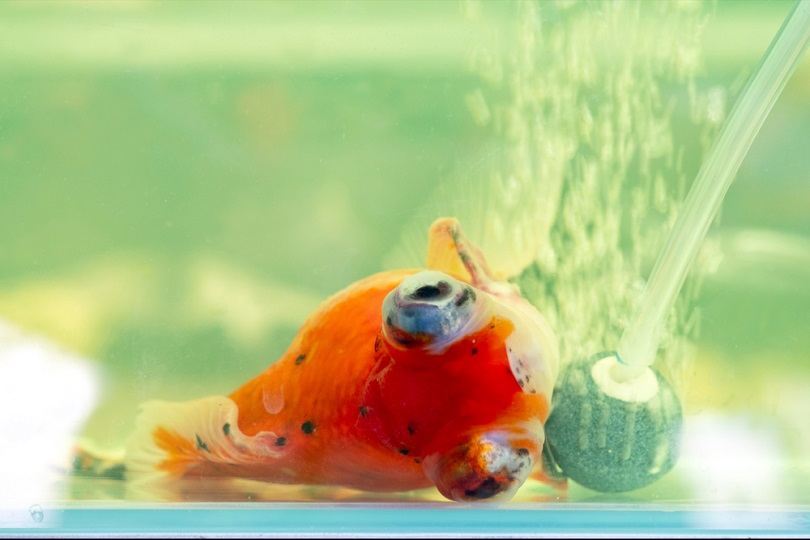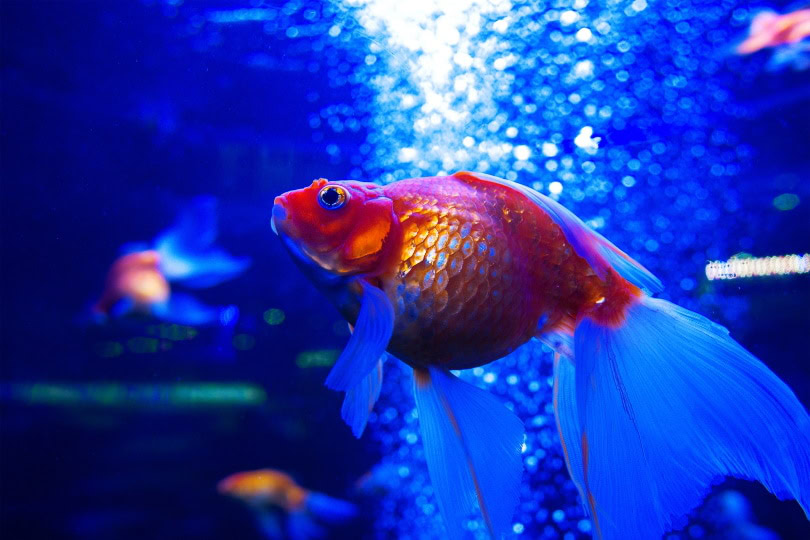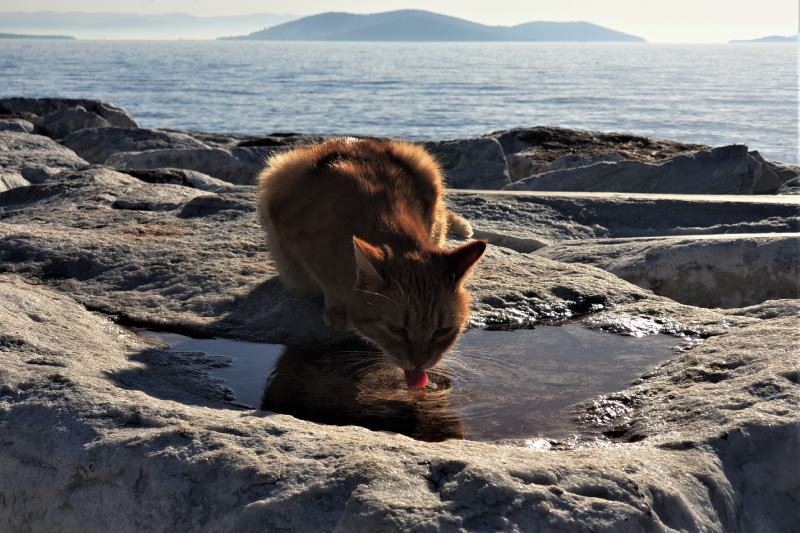Aquarium salt is an old-school remedy that has been used to treat and prevent common goldfish diseases. Some fish keepers recommend adding small traces of salt to goldfish and other fish aquariums to provide the fish with essential electrolytes, but some people only use salt as a natural remedy to treat goldfish diseases before they use medications.
If you get the correct measurements and use salt in the goldfish aquarium when necessary, it can be very effective at treating minor goldfish diseases.

Is Salt Good for Sick Goldfish?
Goldfish are freshwater fish, but they are quite salt-tolerant. They can handle more salt than your average freshwater fish, but the salt must be used properly; otherwise, it can do more harm than good for goldfish. Pure sodium chloride is the best form of salt to use when treating sick goldfish, as it does not contain any impurities and is non-iodized. Avoid using potassium chloride because it is toxic to goldfish and can potentially kill them.
Rock or Kosher salt can work well, but most fish pet stores sell aquarium salt, which is the most inexpensive and commonly used form of salt to treat sick goldfish. Salt can be suitable for goldfish if used correctly, but there is a specific limit to how much salt goldfish can tolerate in their environment long-term. Salt baths or dips are the most practiced way to treat sick goldfish with salt.
You can conduct a salt bath by filling a quarantine or treatment tank with controlled amounts of salt and keeping the goldfish in the tank for a few minutes every couple of hours instead of treating the entire aquarium with salt, which can kill invertebrates, some species of plants, and beneficial bacteria in the filter.
If your fish isn't behaving or looking as it normally does and you suspect it may be sick, ensure you provide the right treatment, by checking out the best-selling and comprehensive book The Truth About Goldfish on Amazon today.

It has entire chapters dedicated to in-depth diagnoses, treatment options, a treatment index, and a list of everything in our fishkeeping medicine cabinet, natural and commercial (and more!).

How Much Salt Can Goldfish Tolerate?
When preventing goldfish diseases, use ½ a teaspoon of non-iodized salt for every 1 gallon (4 liters), or one teaspoon per 3 gallons of water will suffice. A separate treatment tank with one full teaspoon of salt per gallon of water will work because you will not have to worry about accidentally killing plants, beneficial bacteria, or snails and shrimp, as they should not be added to a treatment tank.
For the most part, goldfish can tolerate between 10 and 15 ppt of salt in their water. However, it is important not to overdose the treatment tank or normal aquarium with salt, as this can cause your goldfish to suffer from negative side effects. Too much salt can cause a goldfish to suffer internal damage because its kidneys continuously filter the saline from the water.
How To Use Aquarium Salt Properly To Help Goldfish
Aquarium salt can treat and prevent minor infections and diseases in goldfish. It should not be used alongside other medications since it can counteract or put additional stress on your goldfish’s metabolic system. It should ideally be used as a treatment option for goldfish that are already sick. Salt should be used sparingly in freshwater aquariums because some strains of disease-causing pathogens can become resistant to the salt barrier. This means that you will need to use more salt for future treatments, which can put your goldfish at risk.
Most goldfish keepers have had success using aquarium salt in separate treatment tanks. In these tanks, you can either keep the goldfish for 3 days in a low concentration of aquarium salt (1 teaspoon per three gallons) or do salt baths and dips for 30 minutes every 3 to 5 hours (1 teaspoon per gallon).
Using a treatment tank with salt in is more beneficial than placing the salt directly in the main aquarium because you do not have to worry about accidentally oversalting the main aquarium and ruining the balance of the aquarium’s ecosystem. It will also take a lot of water changes to lower the salinity concentration in the water fully.
If used properly, most external goldfish diseases can be killed by aquarium salt. These diseases can include mild stages of ich, fungus, fin, or mouth rot, and potentially help goldfish suffering from burns from ammonia poisoning to heal faster. It is also possible that salt helps to reduce the toxicity of nitrite to freshwater fish.

Benefits Of Using Salt for Sick Goldfish
Although there are some adverse side effects to keeping your goldfish in water with a high salinity content, the benefits are worth it. It is also important to note that some goldfish can become tolerant to having a higher salinity content in their main aquarium, which can cause their systems to become unbalanced if the salinity content is reduced or changed, so keep this in mind when using salt in the main aquarium for long periods as a preventative measure.
Here are some of the benefits goldfish keepers have observed when treating sick goldfish with pure sodium chloride:
- Helps Kill Bacteria, Fungus, and Parasites: Salt kills fungi, bacteria, and parasites by dehydration. Raising the salinity content helps suck the water out of their thin membranes, which will eventually lead to death. This can help treat goldfish who are suffering from an external disease.
- Salt Is Natural and Usually Effective: Using aquarium salt to treat minor goldfish diseases can prevent the disease from progressing. It is a natural remedy and should be treated as such. You should not use salt as a replacement for proper goldfish medications if you are unsure what disease your goldfish is suffering from or if your goldfish is showing advanced stages of a disease. Salt is typically effective at slowing down the progression of an external disease while being natural and less harsh than other medications like methylene blue or machalite green.
- Provides Goldfish With Essential Electrolytes: Low traces of salt can replace much-needed electrolytes in goldfish by helping them maintain a healthy flow of oxygen and carbon dioxide. This helps goldfish recover faster from infections and diseases that take a toll on their bodies.
- Increases Slime Coat Production: Salt gently irritates a goldfish’s slime coat (the protective mucous barrier on its body), which essentially causes goldfish to produce more of the slime and mucous, and in turn, can help prevent certain diseases and parasites from latching onto your goldfish’s body.

Conclusion
Salt can be beneficial to sick goldfish if it is used correctly. However, avoid taking advantage of a goldfish’s salt tolerance by introducing too much salt into the aquarium when it is not necessary. It is best to only use salt to treat your goldfish when they are ill or suffering from burns caused by poor water conditions.
We hope this article has helped you get a better understanding of how salt can help sick goldfish and how it can be used safely and carefully to achieve the best results.
Featured Image Credit: Kateryna Mostova, Shutterstock










